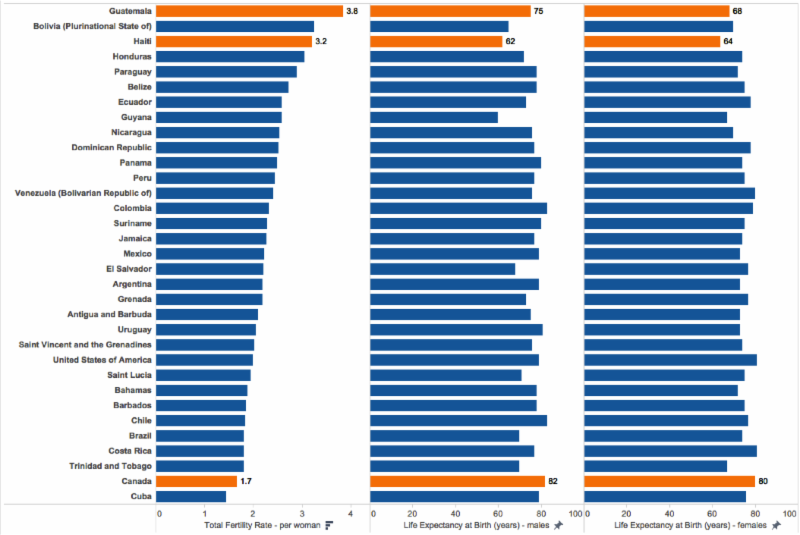Every time my daughter Annie would pull some heart-stopping, daredevil stunt in the swimming pool, on the ski slopes, or while roller-blading with her friends, I would hear two distinct voices in my head. The first was my mother’s as she whispered in a dark and gleeful tone, “I love the smell of payback in the morning…” The other was my own trembling voice saying, “Dude, that maneuver just cost you another year of life; the white light is getting brighter.” There are several reasons why Annie is my only child. Clearly, however, self-preservation tops the list.
Which got me wondering. Is there any evidence to support the idea that having children reduces life expectancy? I decided to create [using data from the World Health Organization (WHO) about fertility rates and life expectancy], a Table Lens to see what might emerge.
A Table Lens is a type of data visualization that quickly reveals potential correlations and/or outliers in a multivariate dataset. Below is the WHO data for the North America Region:
A Table Lens is made up of a series of side-by-side horizontal bar charts with the same categorical variable (fertility rates, life expectancy), but with each chart showing different quantitative variables (number of children per 1,000 women vs. years of life). The variables in the first bar chart are ranked from high to low, keeping associated variables in alignment with them. In this example, I have ranked Total Fertility Rates per Woman from high to low; the corresponding Life Expectancy columns have changed to stay lined up with it. Any potentially interesting correlations or outliers in the data are thereby highlighted for easy identification.
As I considered this first display, data on Haiti and Canada (now orange) caught my attention.
Haiti’s fertility rate is much higher than Canada’s (3.2 versus 1.7 children per 1,000), its life expectancy (62 vs. 82 years for males; 64 versus 80 years for females) far lower. Perhaps my hunch was right: children can kill you.
As I looked at the Table Lens again, though, Guatemala caught my eye.
The fertility rate there is 3.8 versus 3.2 in Haiti and 1.7 in Canada. Although they don’t live as long as Canadians (75 vs. 82 years for males, 68 vs. 80 for females), Guatemalans do (well, the men do) live longer than Haitians (75 vs. 62 years for males, 68 vs. 64 years for females).
Jokes about the effect of parenthood on longevity aside, we can learn some very interesting and useful things by using the brilliantly simple design of the Table Lens. In this example, it shows me, quickly and clearly that the relation between certain countries’ fertility rates and life expectancies may very well worth investigating; I am intrigued, and inspired to dig deeper and learn more. I begin to think in new ways about these relations and factors; they may help me design revelatory research proposals; draft new regulations or grant ideas or project designs; contribute in some way to making people’s lives safer, healthier, more productive and generous. Without the clarity, concision, and fresh perspective a Table Lens can provide, I might have missed something really important.
Therein lies one of the most powerful arguments for understanding why we need to learn how to display data effectively using data visualizations like this one. Without being statisticians or expert epidemiologists, we can display data to throw potentially interesting relationships into high relief, so that we can consider gathering more raw material or pursuing more rigorous statistical testing. The Table Lens helped me realize pretty quickly that my half-humorous hunch about children shortening life expectancy might in fact be true in some parts of the world, and sent me partway along the path to figuring out why. And that awareness could lead in a lot of worthwhile directions. Most assuredly not the end of the journey — but a rather interesting place to start it
Oh, and Annie? She may someday have children of her own, and then it will be my voice whispering, “I love the smell of payback in the morning…”






0 Comments